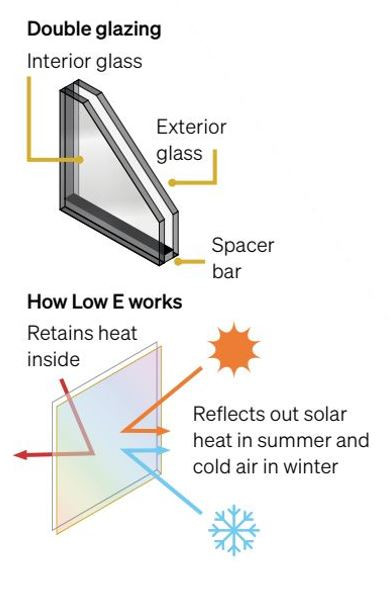
What is Low E Glass?
H1 Building Code changes - what do they mean?
Changes to the NZ Building Code regarding the energy efficiency of our homes were announced in 2021 with all changes taking effect by November 2023.
The overall aim was to ensure that new homes are healthier and more energy efficient, making them warmer, dryer and comfortable rather than the cold, damp and draughty as many of us have experienced in our lives.
Glazing has always been a key component in achieving an effective thermal envelope and the benefits of Low E double glazing specifically are well researched and proven.
In New Zealand, to meet the new H1 building code's energy efficiency updates, most regions are required to use Low E glass in window construction for new builds to achieve compliance. The H1 building code changes do not apply to retrofit double glazing, but they do for any new construction, and using Low E glass in your double glazing will help your home achieve better thermal performance results.

What is Low E glass?
Low E, short for Low Emissivity, refers to a type of glass that has an ultra-thin, transparent coating applied to its surface. This coating is designed to significantly reduce the amount of infrared heat transmitted through the glass, while still allowing visible light to transmit. The primary purpose of Low E glass is to improve energy efficiency and enhance indoor living comforts.

Advantages of Low E glass
There are many reasons why you might choose Low E glass for your windows or doors:
Enhances the energy efficiency of your home
One of the significant benefits of Low E glass is its ability to reduce heat transfer. The low emissivity coating reflects heat back inside during cold weather, keeping the indoor spaces warmer and reducing the need for heating appliances. Similarly, during hot summers, with using the right Low E double glazing solution for solar control will help reflect a portion of the sun's heat, reducing it from entering inside and reducing the reliance on air conditioning.Warmer home in winter
Using Low E double glazing can help keep the heat in your home, meaning less use of heating systems. This helps reduce energy consumption and you save on your power bills.Cooler home in summer
Using solar control Low E or tinted glass these can help reduce solar heat gain keeping your home cooler in summer. They can also reduce the amount of damaging rays coming through which will help to reduce fading of your furnishings too.Reducing condensation on doors and windows
Internal condensation on windows has the potential to adversely affect health through the growth of mould and mildew, as this could lead to respiratory issues such as asthma.Letting in natural Light
Kiwis love natural light, and with the right Low E double glazing can allow visible light to pass through effectively, maintaining a bright and well-lit interior space without sacrificing energy performance.Double glazing reduces heat loss to the exteriors, keeping the interiors and internal glass surfaces warmer compared to single glass. A combination of warmer interiors and warmer internal glass surfaces reduces the likelihood of internal condensation forming. It is also important to have good ventilation in a home to further reduce the chance.
Noise reduction
With the addition of laminate in the double glazing can help reduce outside noise, making it a great investment for those who live by a busy road. It is also recommended that a sound engineer is consulted for optimal results.Enhanced Comfort
Using Low E double glazing to reduce heat gain or loss, creates more comfortable living and working environments year-round. It helps to maintain consistent indoor temperatures, reducing the need for constant adjustments to heating or cooling systems.Safety and security
Where required, safety glass should be automatically upgraded to be compliant with the NZ Building Code. A double-glazed window or door adds a layer of security to a home. This makes the home more difficult to break into, especially if the double glazed unit includes a laminated pane.Privacy at home
Depending on the level of privacy required. There are various options of patterned, obscured/frosted, tinted and reflective glass to suit each style.
Low E Glass Applications in Construction
Low E glass is great for use in residential homes, apartments, commercial buildings, schools or retirement villages. It's offered in various compositions tailored to specific performance objectives. Low E double glazing is also available for windows or doors with a cut out for pet doors.
Find out more about the benefits of Low E double glazing and explore the range of Metro glass options here.
Summer Holiday Closure: 19 December 2025 – 12 January 2026
Metro Performance Glass will be closed for the summer break from midday Friday 19 December 2025 and will reopen Monday 12 January 2026.
Wishing you a safe, relaxing and enjoyable holiday season!